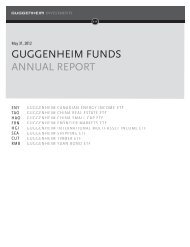Guggenheim Credit Allocation Fund GGM - Guggenheim Investments
Guggenheim Credit Allocation Fund GGM - Guggenheim Investments
Guggenheim Credit Allocation Fund GGM - Guggenheim Investments
- No tags were found...
Create successful ePaper yourself
Turn your PDF publications into a flip-book with our unique Google optimized e-Paper software.
and their political subdivisions, agencies or instrumentalities; foreign governmental issuers; internationalagencies and supranational entities; and special purpose vehicles created for the purpose of issuing structured,collateralized or asset backed securities. The <strong>Fund</strong> may invest in publicly offered credit securities and privatelyoffered credit securities of both public and private issuers.The <strong>Fund</strong> may invest without limitation in securities of non-U.S. issuers, including issuers in emerging markets.The <strong>Fund</strong> may invest without limitation in unregistered securities, restricted securities and securities for whichthere is no readily available trading market or that are otherwise illiquid. Securities within any of the types ofcredit securities in which the <strong>Fund</strong> may invest may be unregistered, restricted or illiquid. The <strong>Fund</strong> may investin privately issued securities of both public and private companies, which may be illiquid. Illiquid securitiesinclude securities legally restricted as to resale, securities for which there is no readily available trading marketor that are otherwise illiquid. The <strong>Fund</strong> may acquire securities through private placements under which it mayagree to contractual restrictions on the resale of such securities.Under normal market conditions, the <strong>Fund</strong> may invest up to 20% of its Managed Assets in ABS. Under normalmarket conditions, the <strong>Fund</strong> will not invest in ABS that are, at the time of investment, rated below investmentgrade, or, if unrated, judged to be below investment grade quality by the Adviser.As an alternative to holding investments directly, the <strong>Fund</strong> may also obtain investment exposure to securities inwhich it may invest by investing up to 20% of its Managed Assets in other investment companies. The <strong>Fund</strong>may invest in open-end funds, closed-end funds and exchange-traded funds. For purposes of the <strong>Fund</strong>’s policyof investing at least 80% of its net assets, plus the amount of any borrowings for investment purposes, in creditsecurities (the “80% Policy”), the <strong>Fund</strong> will include its investments in other investment companies that have apolicy of investing at least 80% of their net assets, plus the amount of any borrowings for investment purposes,in one or more types of credit securities. See “The <strong>Fund</strong>’s <strong>Investments</strong>—Other Investment Companies.”“Managed Assets” means the total assets of the <strong>Fund</strong>, including the assets attributable to the proceeds fromfinancial leverage, including the issuance of senior securities representing indebtedness (including throughborrowing from financial institutions or issuance of debt securities, including notes or commercial paper), theissuance of preferred shares, the effective leverage of certain portfolio transactions such as reverse repurchaseagreements and/or dollar rolls, or any other form of financial leverage, minus liabilities, other than liabilitiesrelated to any financial leverage. Managed Assets includes assets attributable to financial leverage of any form.The <strong>Fund</strong> may, but is not required to, use various derivatives transactions for hedging and risk managementpurposes, to facilitate portfolio management and to earn income or enhance total return. The use of derivativestransactions to earn income or enhance total return may be particularly speculative. Derivatives are financialinstruments the value of which is derived from a reference instrument. The <strong>Fund</strong> may engage in a variety ofderivatives transactions. The <strong>Fund</strong> may purchase and sell exchange-listed and over-the-counter put and calloptions, purchase and sell futures contracts and options thereon, and enter into swap, cap, floor or collartransactions. The <strong>Fund</strong> may utilize derivatives that reference one or more securities, indices, commodities,currencies or interest rates. In addition, the <strong>Fund</strong> may utilize new techniques, transactions, instruments orstrategies that are developed or permitted as regulatory changes occur. The <strong>Fund</strong> has not adopted a maximumpercentage limit with respect to derivatives transactions. See “The <strong>Fund</strong>’s <strong>Investments</strong>—DerivativesTransactions” in this prospectus and “Investment Objective and Policies—Derivative Instruments” in the SAIfor additional information about particular instruments and transactions that the <strong>Fund</strong> may enter into.As an alternative to holding investments directly, the <strong>Fund</strong> may also obtain investment exposure throughderivatives transactions intended to replicate, modify or replace the economic attributes associated with aninvestment in securities in which the <strong>Fund</strong> may invest directly. The <strong>Fund</strong> may be exposed to certain additionalrisks should the Adviser use derivatives as a means to synthetically implement the <strong>Fund</strong>’s investment strategies.Such transactions may expose the <strong>Fund</strong> to counterparty risk, lack of liquidity in such derivative instruments andadditional expenses associated with using such derivative instruments. To the extent that the <strong>Fund</strong> invests insynthetic investments with economic characteristics similar to credit securities, the value of such investmentswill be counted as credit securities for purposes of the <strong>Fund</strong>’s 80% Policy.The <strong>Fund</strong> may engage in certain investment transactions described herein. The <strong>Fund</strong> may enter into forwardcommitments for the purchase or sale of securities. The <strong>Fund</strong> may enter into transactions on a “when issued,”3



